2013 AUDI S4 SEDAN service
[x] Cancel search: servicePage 228 of 294
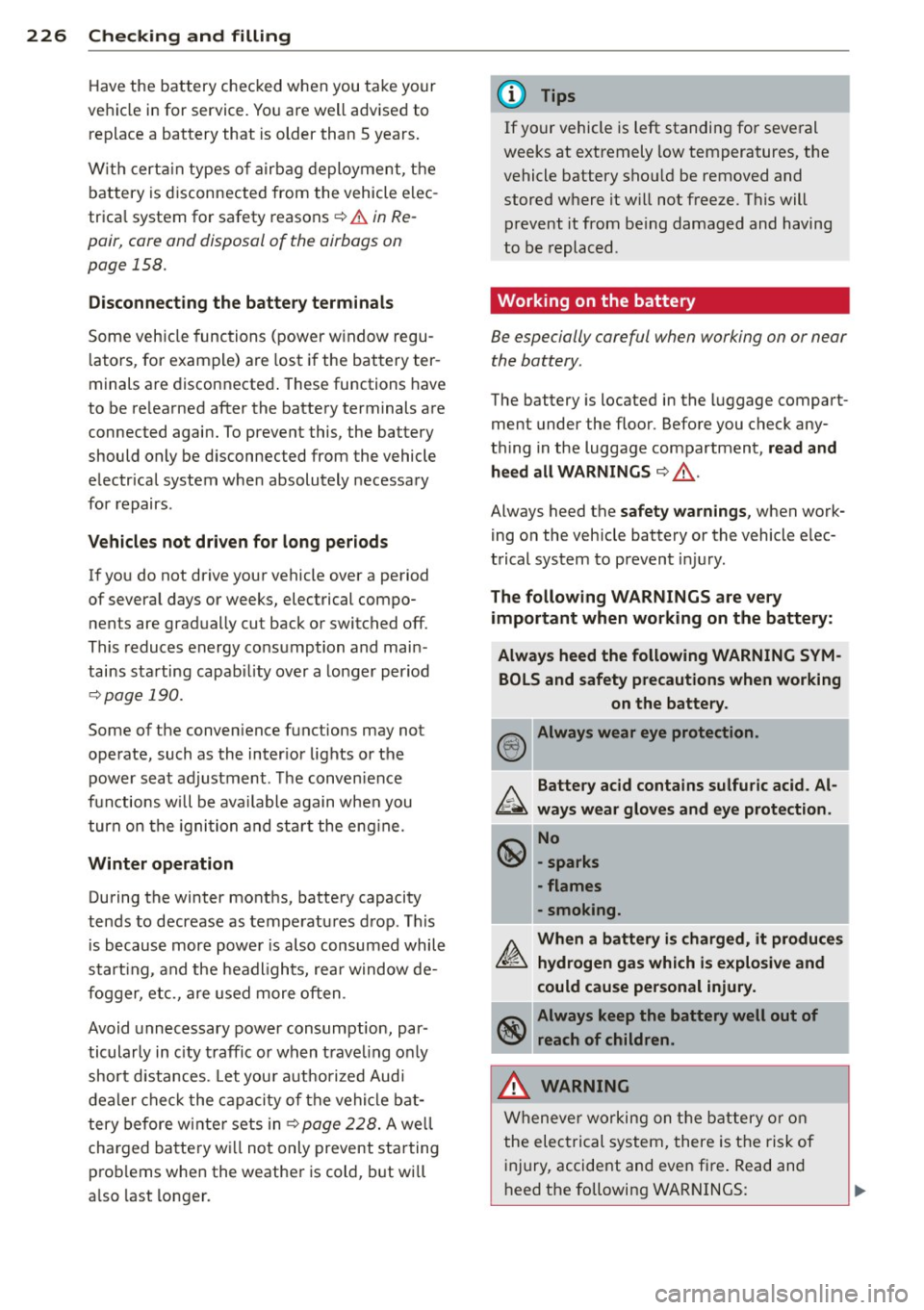
226 Check ing and filling
Have the battery checked when you take your
vehicle in for service. You are well advised to replace a battery that is older than 5 years.
W ith certa in types o f airbag deployment, the
battery is disconnected from the vehicle elec
trica l system for safety reasons¢
& in Re
pair, core and disposal of the airbags on
page 158.
Disconn ect ing the battery terminal s
Some vehicle functions (power window regu
lators, for example) are lost if the battery ter
minals are disconnected . These functions have
to be re learned after the battery terminals are
connected again. To prevent this, the battery
should only be disconnected from the vehicle
electrical system when absolutely necessary
for repairs .
Vehicles not dri ven fo r lo ng p eriod s
If you do not drive your vehicle over a period
of several days or weeks, electrical compo
nents are gradually cut back or switched off.
This reduces energy consumption and main
tains starting capabil ity over a longer period
¢ page 190.
Some of the conven ience functions may not
operate, such as the inter ior lights or the
power seat adjustment. The conven ience
functions will be ava ilable again when you
turn on the ignition and start the eng ine.
Winter operati on
During the winter months, battery capacity
tends to decrease as temperatu res drop . This
is because more power is also consumed while
start ing , and the headlights, rea r window de
fogger, etc., are used more often .
Avoid unnecessary power consumption, par
ticularly in c ity traffic or when traveling on ly
short distances. Let you r authorized Audi
dea ler check the capacity of the vehicle bat
tery before winter sets in
¢ page 228. A well
charged batte ry w ill not only prevent sta rting
prob lems when the weather is cold, but wi ll
a lso last longer.
(D Tips
If your vehicle is left standing for seve ral
weeks at extremely low temperatures, the
vehicle battery sho uld be removed and
stored where it w ill not freeze . This will
prevent it from be ing damaged and having
to be replaced .
Working on the battery
Be especially careful when working on or near
the battery.
The battery is located in the luggage compart
ment under the floor. Before you check any
t hi ng in the luggage compartment,
read and
heed all WARNINGS
¢ ,& .
Always heed the safety warnings , when work
ing on the vehicle battery or the vehicle e lec
trical system to prevent injury.
Th e follo wing WARNINGS are very
important when working on the battery :
Al ways heed the follo wing WARNING SYM
BOLS and safety prec aution s when working
on the battery .
® Always wear eye protection .
,0,. Battery acid contains sulfuric acid . Al
~ way s wear glov es and ey e prot ectio n.
~ No
\!SI -sparks
-flames
-smoking.
A Wh en a battery is charged , it produ ce s
~ hydro gen gas which is e xplosi ve and
c o uld cau se pe rson al injur y.
~ Always keep the battery well out of
'if!:11 reach of children .
_& WARNING
Whenever working on the battery or on
the electrical system, there is the risk of
injury, accident and even fire . Read and
heed the following WARNINGS:
-
Page 240 of 294
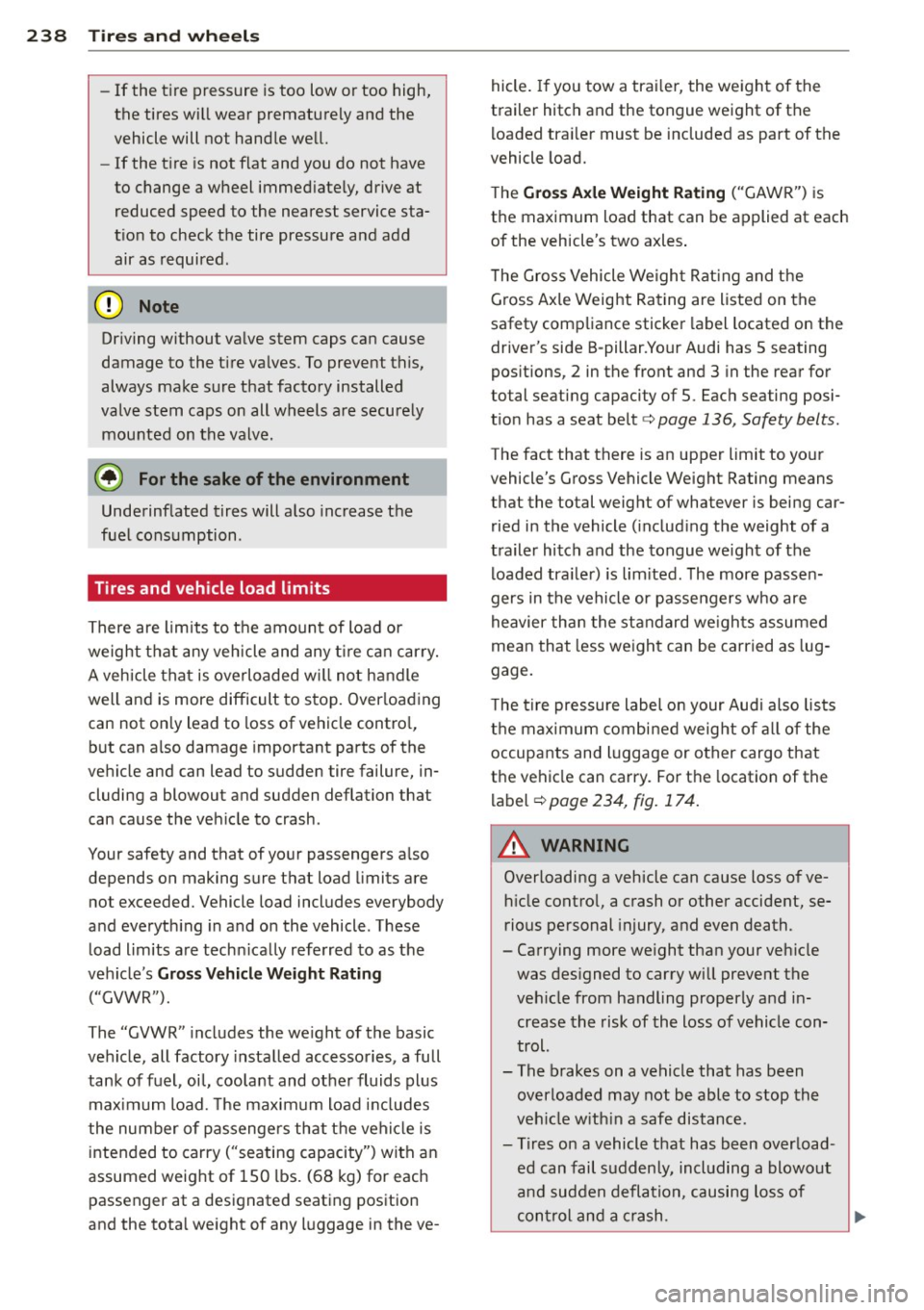
238 Tires and wheels
-If the tire pressure is too low or too high,
the tires will wear prematurely and the
vehicle will not handle well.
- If the tire is not flat and you do not have
to change a wheel immediately, drive at
reduced speed to the nearest service sta
t ion to check the tire pressure and add
air as required.
(D Note
Driving without valve stem caps can cause
damage to the tire va lves. To prevent this,
always make sure that facto ry installed
valve stem caps on all wheels are securely mounted on the valve.
@ For the sake of the environment
Underinflated tires will also increase the
fuel consumption .
Tires and vehicle load limits
There are limits to the amount of load or
weight that any vehicle and any tire can carry.
A vehicle that is overloaded w ill not handle
well and is more difficult to stop. Overloading
can not only lead to loss of vehicle control,
but can a lso damage important parts of the
vehicle and can lead to sudden tire failure, in
cluding a blowout and sudden deflation that
can cause the vehicle to crash .
Your safety and that of your passengers a lso
depends on making sure that load limits are
not exceeded. Vehicle load includes everybody
and everything in and on the vehicle . These
load limits are techn ically referred to as the
vehicle's
Gross Vehicle Weight Rating
("GVWR").
The "GVWR" includes the weight of the basic
vehicle, all factory installed accessories , a full
tank of fuel , oi l, coolant and other fluids plus
maximum load. The maximum load includes
the number of passengers that the vehicle is
intended to carry ("seating capacity") with an
assumed weight of 150 lbs . (68 kg) for each
passenger at a designated seating position
and the tota l weight of any luggage in the ve- hide.
If you tow a trai ler, the weight of the
trailer hitch and the tongue weight of the loaded trailer must be included as part of the
vehicle load.
T he
Gross Axle Weight Rating ("GAWR") is
the maximum load that can be applied at each
of the vehicle's two axles .
T he Gross Vehicle Weight Rating and the
Gross Axle Weight Rating are listed on the
safety compliance sticker label located on the
driver's side B-pillar.Your Audi has 5 seating
positions, 2 in the front and 3 in the rear for
total seating capacity of 5. Each seating posi
tion has a seat belt <=>
page 136, Safety belts .
The fact that there is an upper limit to yo ur
vehicle's Gross Vehicle Weight Rating means
that the to tal weight of wha tever is being car
ried in the vehicle ( including the weight of a
tra iler hitch and the tongue weight of the
loaded trailer) is lim ited. The more passen
gers in the vehicle or passengers who are
heavier than the standard we ights assumed
mean that less we ight can be carried as lug
gage.
T he tire pressure label on your Audi also lists
the maximum combined weight of all of the
occupants and luggage or other cargo that
the vehicle can carry. For the location of the
label <=>page234 , fig.174.
A WARNING
-Overloading a vehicle can cause loss of ve-
hicle control, a crash or other accident, se
rious personal injury, and even death.
- Carrying more we ight than your vehicle
was des igned to carry will prevent the
veh icle from handling properly and in
crease the risk of the loss of vehicle con
trol.
- The brakes on a vehicle that has been
overloaded may not be able to stop the
veh icle with in a safe distance .
- Tires on a vehicle that has been overload
ed can fail suddenly, incl uding a blowout
and sudden deflation, causing loss of
con trol and a crash .
Page 242 of 294
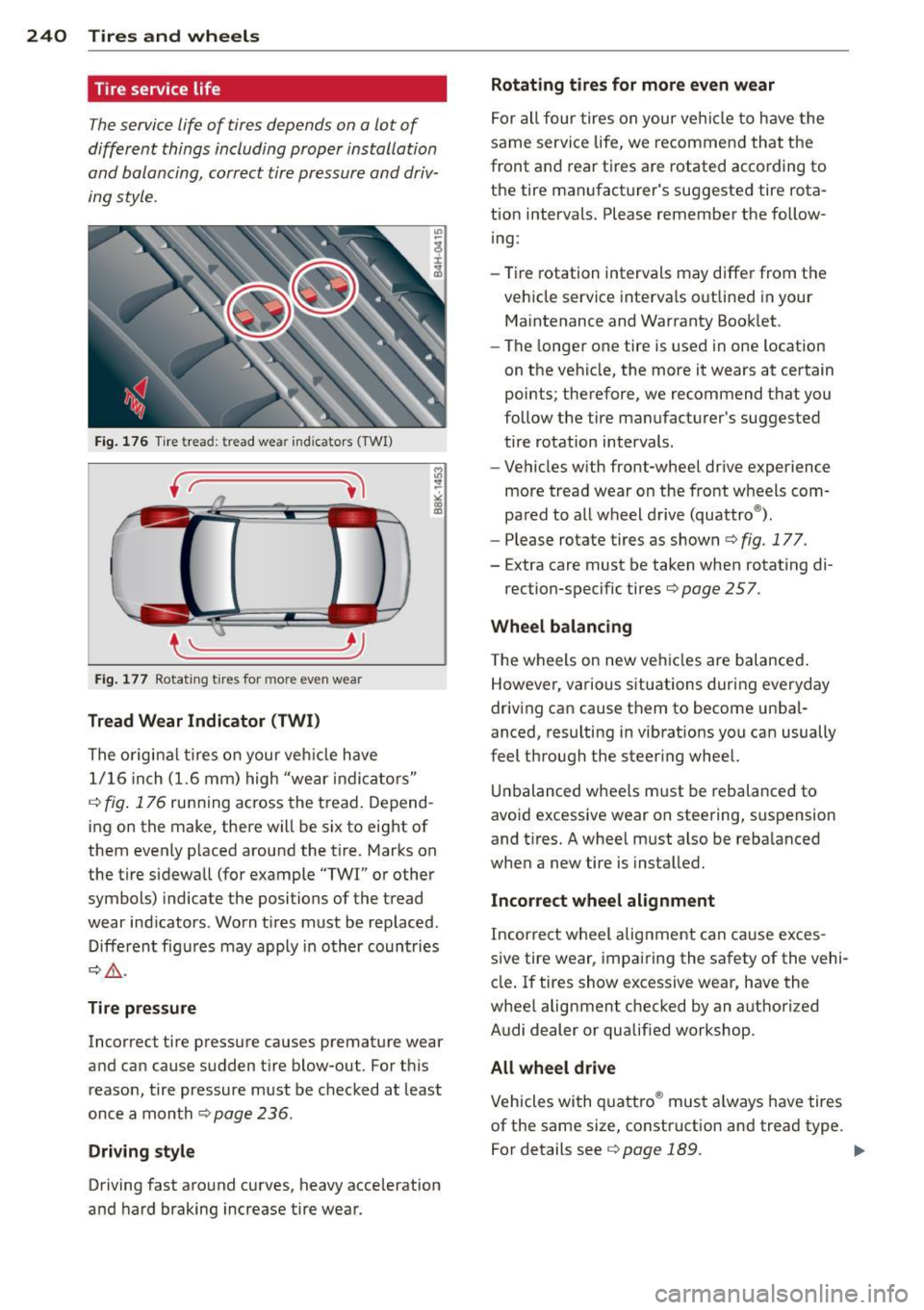
240 Tires and wheels
Tire service life
The service life of tires depends on a lot of
different things including proper installation
and balancing, correct tire pressure and driv
ing style.
F ig. 176 Tire tread: tre ad wea r ind icators (TWI)
_____ __,.J)
F ig. 1 77 Rotat ing t ires for more ev en wea r
Tread Wear Indicator (TWI)
The o rigi na l t ires on your veh icle have
1/16 inch (1.6 mm) high "wear indicators"
c::> fig . 176 running across the tread. Depend
i ng on the make, there will be six to eight of
them evenly p laced around the t ire. Marks on
the tire sidewa ll (for example "TWI" or other
symbols) indicate the positions of the tread
wear ind icators . Worn t ires must be replaced .
Different fig ures may apply in o ther countries
c::> & .
Tire p ressure
Incorrect tire pressure causes premature wear
a nd can cause sudden t ire blow-out. For th is
reason, tire pressure must be checked at least
once a month
c::> page 236.
Driving style
Driving fast aro und curves, heavy acce leration
and hard braking increase tire wear.
Rotating tires for more even wear
F or all four tires on your ve hicl e to h ave the
same service life, we recommen d that t he
front and rear t ires are rotated according to
the tire manufact urer's suggested tire rota
tion intervals. Please remember the follow ing :
- Tire rotation intervals may differ from the
vehicle service inte rva ls o utlined in your
Ma intenance and Warranty Book let .
- The longer one tire is used in one location
on the vehicle, the more it wears at certain
points; therefore, we recommend that you
follow the tire manufact urer's suggested
tire rotation intervals .
- Vehi cles w ith front-wheel dr ive experience
more tread wear on the fro nt w heels com
pa red to all wheel d rive (quattro ®).
- Please rotate tires as shown
c::> fig. 177.
-Extra care must be taken when rotating di-
rection-specific tires
c::> page 2 5 7 .
Wheel balancing
The wheels on new ve hicles are balanced .
However, various situations during everyday
driving can cause them to become unba l
anced, re sulting in vibrat ions you can usually
feel through the steer ing wheel.
Un balanced whee ls must be rebalanced to
avoid excessive wear on steering, suspension
and t ires. A whee l m ust also be reba lanced
when a new tire is insta lled.
Incorrect wheel alignment
Incor rect wheel alig nment can cause exces
sive tire wear, impairing the safety of the veh i
cle . If tires show excessive wear, have the
whee l alignment checked by an aut hori zed
Audi dealer or qualif ied workshop .
All wheel drive
Vehicles with q uattro ® mus t always have tires
of the same size, construction and tread type .
For details see
c::> page 189. ..,.
Page 274 of 294
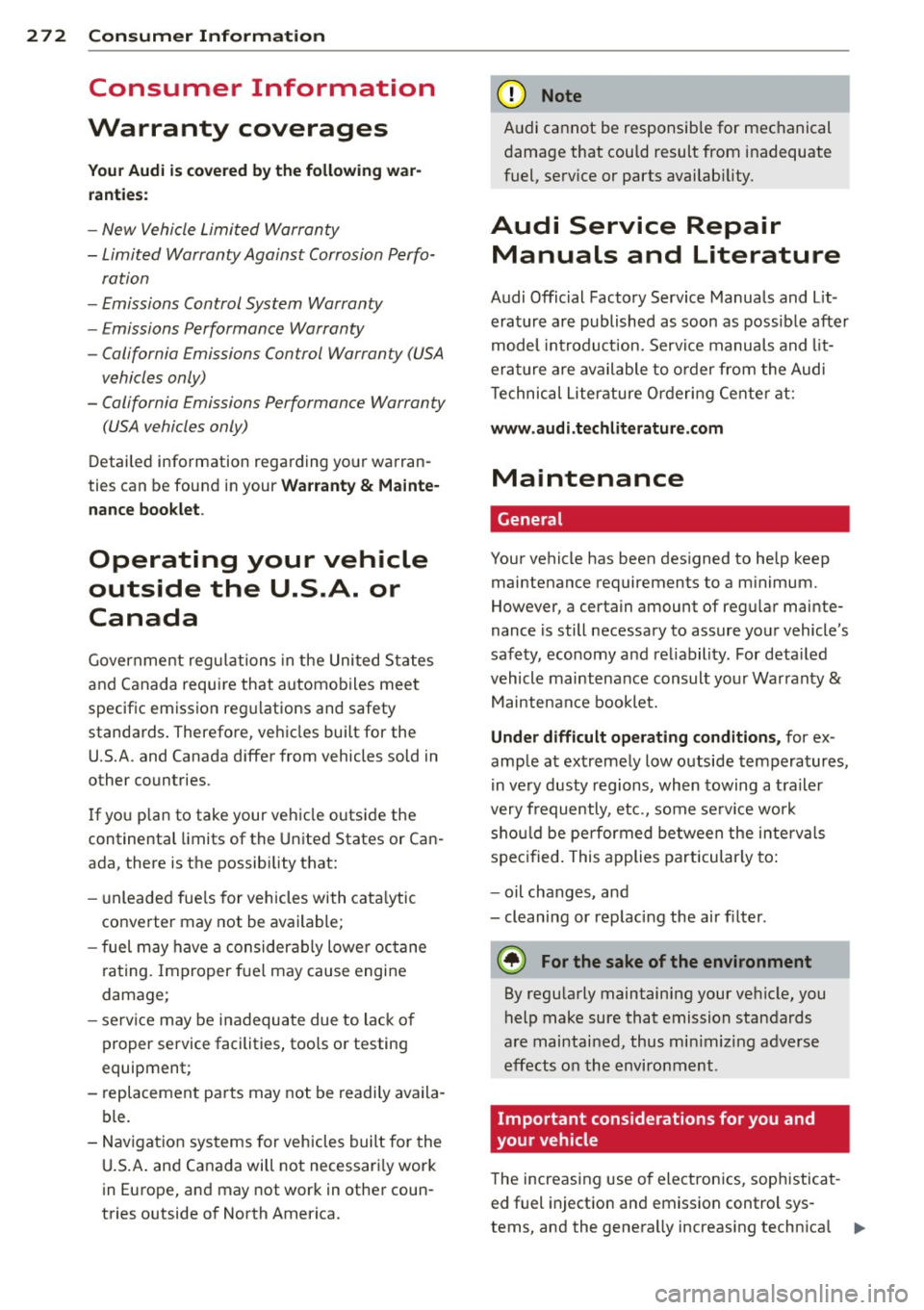
272 Consumer Information
Consumer Information
Warranty coverages
You r Audi is covered by the following war
ranties:
- New Vehicle Limited Warranty
- Limited Warranty Against Corrosion Perfo-
ration
- Emissions Control System Warranty
- Emissions Performance Warranty
- California Emissions Control Warranty (USA
vehicles only)
- California Emissions Performance Warranty
(USA vehicles only)
Detailed information regarding your warran
ties can be found in your
Warranty & Mainte
nance booklet .
Operating your vehicle
outside the U.S.A. or
Canada
Government regu lations in the United States
and Canada require that automobiles meet
specific emission regulations and safety
standards. Therefore, veh icles built for the
U.S.A . and Canada differ from vehicles sold in
other countries .
If you p lan to take your vehicle outside the
continental limits of the United States or Can
ada, there is the possibility that:
- unleaded fuels for vehicles with cata lytic
converter may not be available;
- fuel may have a considerably lowe r octane
rating. Improper fuel may cause engine
damage ;
- service may be inadequate due to lack of
proper service facilities, tools or testing
equipment ;
- replacement pa rts may not be readily availa
ble.
- Navigation systems for vehicles built for the
U.S.A. and Canada will not necessar ily work
in Europe, and may not work in other coun
tries outside of North America.
(D Note
Audi cannot be responsible for mechanical
damage that could result from inadequate
fuel, service or parts availability.
Audi Service Repair Manuals and Literature
Audi Official Factory Service Manuals and Lit
erature are published as soon as possible after
model introduction. Service manuals and lit
erature are available to order from the Audi
T echnical Literature Ordering Center at:
www.audi.techliterature.com
Maintenance
General
Your vehicle has been designed to help keep
maintenance requirements to a minimum.
However, a certain amount of regular mainte
nance is still necessary to assure your vehicle's
s afety, economy and rel iability. For detailed
vehicle maintenance consult your Warranty &
Maintenance booklet.
Under difficult operating conditions, for ex
ample at extremely low outside temperatures,
i n very dusty regions , when towing a trailer
very frequently, etc., some service work
should be performed between the intervals
specified. This applies particularly to:
- oil changes, and
- cleaning or replacing the air filter .
(® For the sake of the environment
By regularly maintaining your vehicle, you
help make sure that emission standards
are maintained, thus minimizing adverse
effects on the environment.
Important considerations for you and
your vehicle
The increasing use of electronics, sophisticat
ed fuel injection and emission contro l sys-
tems, and the genera lly increasing technical
liJJ,
Page 279 of 294

A
Accessories . . . . . . . . . . . . . . . . . . . . 60, 274
AC (automatic climate control) ... .. .. .. 69
adaptive cruise control Vehicles with manual transmission 99
Adaptive cruise control ...... .. .. .. .. .. 97
C leaning sensors/camera ... ... .. .. . 201
Messages .. ................ ... ... 105
Request for driver intervention . . . . . . . 103
Setting the driving program .. .. .. .. . 102
Adaptive dampers .......... .. .. .. .. . 111
Adaptive light ................ ... ... . 44
Adaptive Light (defective) ......... .. .. 22
Adding Engine coolant ........... .. .. .. .. .
Engine oil .. ................ ... .. .
Windshield washer fluid ......... .. .
Additional accessories
Additives 223
220
229
274
Engine oil .. ............. .... .. .. . 220
Adjustable steering column ... ... .. .. .. 72
Adjusting Air distribution (automatic climate con-
trol) . . . . . . . . . . . . . . . . . . . . . . . . . . . . . . 70
I nstrument illumination ... .. .. .. .. .. 47
Steering column .................... 72
Temperature (automatic climate control) 70
Airbag Warning/indicator lights ... .. .. .. .. .. 20
Airbag system . . . . . . . . . . . . . . . . . 144 , 161
Advanced Airbag System ....... ... .. 148
Advanced Airbag System components . 151
Care . .. ... . .... ... ..... ..... .. ... 157
Children . .. ............. .... .. .. . 166
Child restraints ........... .. .. .. ... 167
Components (front airbags) . . . . . . . . . 151
Danger of fitting a child safety seat on
the front passenger seat . . . . . . . . . . . . 145
Disposal . .. .. ........... .. .. .. ... 157
Front airbags . . . . . . . . . . . . . . . . 148, 149
How do the front airbags work? . . . . . . 153
How many airbags does my vehicle
have? 151
How the Advanced Airbag System com-
ponents work together .... .. .. .. .. . 152
Important things to know .. .. .. .. .. . 144
Index 277
Indicator light ..... ............... 155
Monitoring . ... .... ............... 155
PASSENGER AIR BAG OFF light ....... 155
Repairs ... .. .. .. ................. 157
Safety instructions ................. 157
Side airbags ..... .. ............... 159
Side curtain airbags .. .... .. .... .... 162
Weight-sensing mat ............... 166
When must the system be inspected? . 155
all-wheel drive .. .. ................. 189
Alloy wheels .. .... .. ............... 204
All wheel drive Winter tires . .. .. .... ........... .. 245
Anti-free ze
refer to Engine coolant system ... .. .. 222
Anti-lock braking system ............ . 184
Warning/indicator lights ............ . 19
Anti-slip regulation ................. 184
Anti-theft alarm warning system ... .. .. . 32
Anti-theft systems Electronic immobilizer ............... 38
Armrest .. .. .. .. .. .. . ... ...... ... .. . 56
Ashtray ...... .. .. .................. 59
Asterisk What does it mean when something is
marked with an asterisk? . . . . . . . . . . . . . . 6
Audi braking guard
refer to braking guard . ........... .. . 97
Audi drive select . . . . . . . . . . . . . . . . . . . . 111
Adaptive dampers .. .............. . 111
Description . . . . . . . . . . . . . . . . . . . . . . . 111
Dynamic steering . .... ......... .. .. 111
Setting the driving mode ........ .. .. 112
Sport differential . .... ............. 111
Audi Service Repair Manuals and Litera-
ture 272
AU TO
Automatic climate control . . . . . . . . . . . . 70
Automatic headlights . ...... ... .. .. . 44
Auto Lock ... ... .... ................ 32
Automatic belt retractor ............. 139
Automatic car wash
refer to Washing . .. ........... .... 200
Automatic climate control Air vents . . . . . . . . . . . . . . . . . . . . . . . . . . 70
Operation . . . . . . . . . . . . . . . . . . . . . . . . . 69
Setup ........ .. .. . ............... 71
•
•
Page 288 of 294
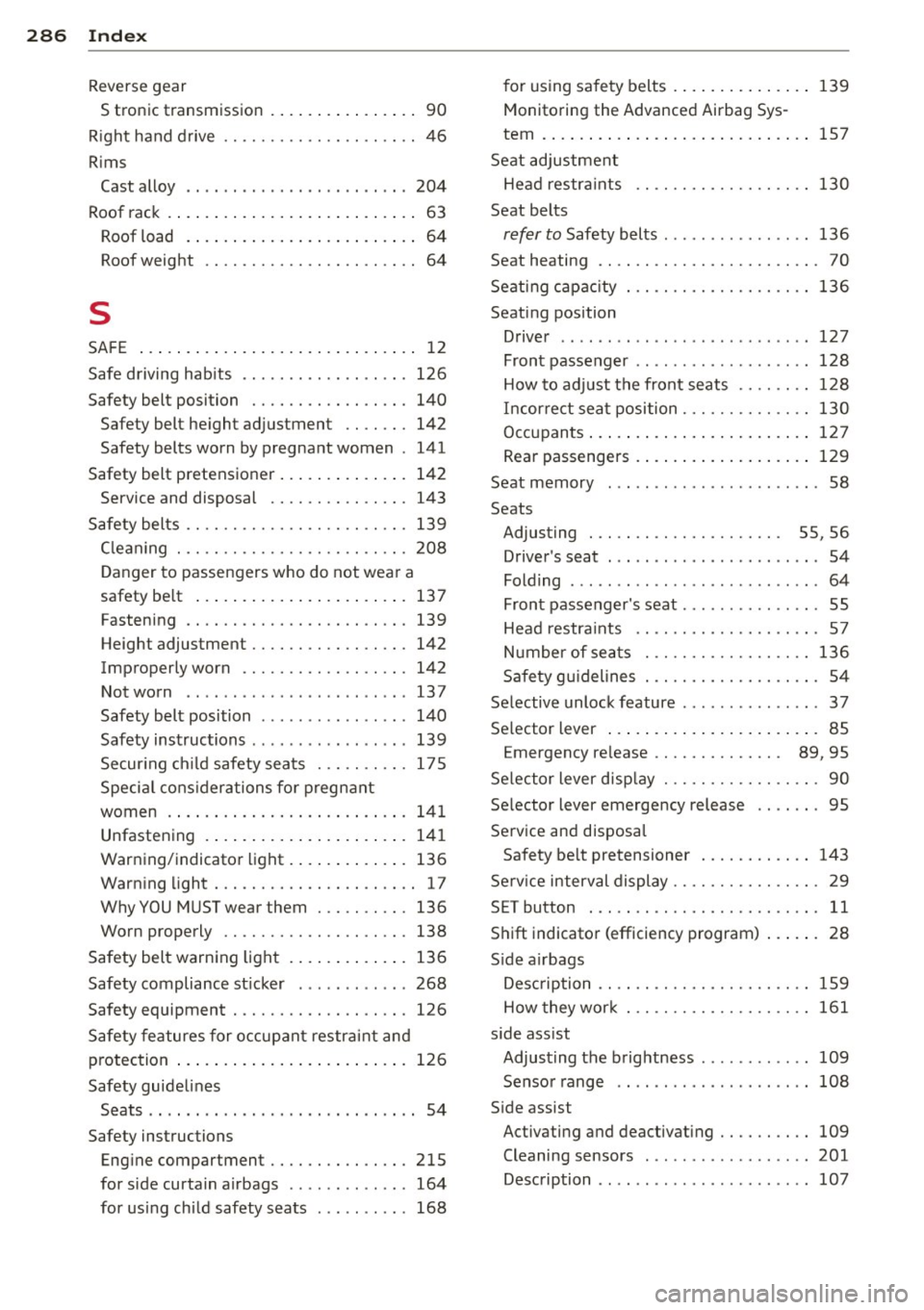
286 Index
Reverse gear S tronic transmission . ... .. .. ... ... .. 90
R ight hand d rive ........... .... .... .. 46
R ims
Cast alloy .. ... . ...... ... .. .. .. .. . 204
Roof rac k . . . . . . . . . . . . . . . . . . . . . . . . . . . 63
Roof load . . . . . . . . . . . . . . . . . . . . . . . . . 64
Roof weight . . . . . . . . . . . . . . . . . . . . . . . 64
s
SA FE ..... .. ... .. ..... ... .. .. .... .. 12
Safe driving hab its ...... ... .. .. .. .. . 126
Safety belt position . . . . . . . . . . . . . . . . . 140
Safety belt he ight adjustment .. .... . 142
Safety belts worn by pregnant women . 141
Safety belt pretensioner ... .. .. .. .... . 142
Service and disposal . . . . . . . . . . . . . . . 143
Safety belts .... ........... .. .. .... . 139
C leaning . .. ............. .... .. .. . 208
D anger to passengers who do not wea r a
safety be lt . . . . . . . . . . . . . . . . . . . . . . . 13 7
Fastening .... ........... .. .. .... . 139
Height adjustment ........ .. .. .. .. . 142
Improperly worn . . . . . . . . . . . . . . . . . . 142
Not worn .. .................. .... 137
Safety belt position ........ ... .. .. . 140
Safety instructions . . . . . . . . . . . . . . . . . 139
Secur ing c hild safety sea ts . .. .. .. ... 175
Speci al consider ations fo r pregnant
women . ... .. .. ...... ... .. .. .... . 141
Unfasten ing . .. .. ..... ... .. .. .... . 141
Warning/ indicato r light . ... .. .. .. .. . 136
Warn ing light . ........... .. .. .... .. 17
WhyYOU M USTwearthem . .. .. .. ... 136
Worn properly ............. .. .... . 138
Safety belt warning light . ... .. .. .... . 13 6
Safety compliance st icker . ...... .. .. . 268
Safety equipment ............ .. .... . 126
Safety fe atures for o ccup ant restra int and
p rotec tion ... ... .. ..... ... .. .. .... . 12 6
Safety guidel ines
Seats .. .. .. ........ ..... .. ........ S4
Safety instructions Eng ine compartment ...... .. .. .. .. . 215
for side curtain a irbags .. .. .. .. .. .. . 164
for us ing chi ld safety seats ..... .. ... 168 f
o r using sa fe ty belts . .. ..... ... .. .. 139
Monito ring the Advanced Airbag Sys-
tem . ... .. .. .. .. .. ... .. ..... ... .. 157
Seat adjustment He ad restra ints .. ............. .... 130
Seat belts
refer to Safety belts ............... . 136
Seat heating ...... ............. .... . 70
Se ating c apac ity . .. ... .......... .. .. 136
Seating pos ition
D rive r ... ... .. .. .. ... ... ... .. .. .. 127
Front passeng er .. .......... ...... . 128
How to ad just the fron t seats .. .. .. .. 1 28
Incor re ct sea t position .......... .. .. 130
Occ upan ts ..... .. ... .. ..... ... .. .. 12 7
Rear passengers . .... .. ..... .... . .. 129
Seat memory . . . . . . . . . . . . . . . . . . . . . . . 58
Seats Adjusting . . . . . . . . . . . . . . . . . . . . . 5S, 56
Driver's seat . . . . . . . . . . . . . . . . . . . . . . . 54
Folding ....... .. .. ... ....... ... .. . 64
Front passenger's seat . . . . . . . . . . . . . . . 5S
Head restra ints .. ... .......... .. .. . 57
N umber of sea ts . ............. .. .. 136
Sa fe ty g uid elines ................ .. . 54
Se lective unlock feature . . . . . . . . . . . . . . . 3 7
Se lector lever ..... .. ... ..... ... .. .. . 8S
Emergency re lease . . . . . . . . . . . . . . 89, 9S
Se lector lever d isp lay . ........... .. .. . 90
Se lector lever emergency release ...... . 9S
Se rvice and disposa l
Safety be lt pretensioner . . . . . . . . . . . . 143
Se rv ice interv al d is play . . . . . . . . . . . . . . . . 29
SET button . . . . . . . . . . . . . . . . . . . . . . . . . 11
S hi ft indicato r (efficiency program) ... .. . 28
S ide a irbags
Des cription ...... ............. .... 159
How they wor k ... ............. .... 161
s ide ass ist
Adjus ting the b rightness . ........... 109
Senso r range .. .. ................ . 108
S ide assist
Activati ng and deactivating .... .. .. .. 109
Cleaning sensors .... .. .. ... ..... .. 201
Desc ription .. .. .. .......... ... ... . 107
Page 290 of 294

288 Index
Tires and wheels
Checking tire pressure .............. 236
Cold t ire inflation pressure ... .. .... . 234
Dimensions .............. .. .. .... . 241
General notes . ............. .. .... . 230
Glossary of tire and loading terminolo -
gy .. .. .. .. ... .... ...... .. .. .. .. . 231
New tires and wheels .......... .. .. . 241
Replacing . . . . . . . . . . . . . . . . . . . . . . . . 242
Snow chains .. ........... .. .. .... . 246
Tires and vehicle load limits . ... .. .. . 238
Wheel bolts .............. ... .... . 247
Winter tires .............. ... .... . 245
Tire service life . ........... .... .... . 240
Tool kit . .. ................. .. .... . 251
Torn or frayed safety belts ............ 139
Touch-up paint . .. ...... .... ... .. .. . 202
Towing Front eyelet ............. .. .. ..... 265
Rear eyelet ... ........... .... .... . 265
Tow truck procedures .......... .. ... 264
TPM5 Tire pressure monitoring system .. ... 249
Trailer towing ... .......... .. .. .. .. . 196
Operating instructions ......... .. .. . 196
Technical requirements . . . . . . . . 196, 197
Tips ..... .. ................ ..... . 198
Transmission ............ .. .. .. .. .. .. 83
6-speed manual transmission . . . . . . . . . 83
multitronic . . . . . . . . . . . . . . . . . . . . . . . . 83
S tronic .... ................ ..... .. 89
tiptronic . . . . . . . . . . . . . . . . . . . . . . . . . . 83
Transmission malfunction (ind icator lamp) 95
Transmission malfunction (indicator light) 88
Transport Canada ................... 134
Travel mode ... .. ...... .... ... .. .. .. 46
Tread Wear Indicator (TWI) ... ... .. .. . 240
Trip computer
Fu el consumption . . . . . . . . . . . . . . . . . . 25
Mileage .................... ..... .. 25
Sing le-trip memory ........ ..... .. .. 25
Total-trip memory . . . . . . . . . . . . . . . . . . 25
Trip odometer ............. .... .... .. 12
Trunk
refer to Luggage compartment . . . 64, 132
Trunk escape handle ................ .. 40 Trunk
lid
refer to Rear lid . ................. .. 39
Turn signals . .... .. ............. ..... 45
Warning/indicator lights .......... .. . 23
u
Undercoating ..... ................ . 204
Unfastening safety belts ......... .. ..
141
Unidirectional tires .............. .... 230
Uniform tire quality grading .......... 244
Unlocking Rear lid ... .... .. ................. . 39
Unlocking/locking at the lock cylinder . . . . . . . . . . . . . . . . . . 3 7
by remote control ................ .. 35
with the centra l locking switch ..... .. . 36
with the convenience key ...... .. .. .. . 36
Use of jumper cables ............ .... 263
V
Valet parking ...... ................ .. 43
Vanity mirrors ..... ............. ..... 49
Vehicle-care products . . . . . . . . . . . . . . . . 199
Vehicle electrical system . . . . . . . . . . . . . . 17
Vehicle Identification Number (VIN) .. .. 268
Vehicle jack . .. .. .. ... .......... .... 255
Vehicle key . . . . . . . . . . . . . . . . . . . . . . . . . 33
Vehicle literature .. ............. ...... 5
Vehicle tool kit . ... ....... ...... .. .. 251
Ventilation . .. .. .. ............. .. .. . 68
w
Warning/indicator lights . . . . . . . . . . 10 , 13
Airbag system ... ................ .. 20
Anti-lock braking system (ABS) . .. .. .. . 19
Brake system .. .. ... .......... .. .. . 15
Electromechanical parking brake . .. .. . 16
Electronic power control . . . . . . . . . . . . . 20
Electronic Stabilization Control (ESC) .. . 19
Generator . . . . . . . . . . . . . . . . . . . . . . . . . 17
Malfunction Ind icator Lamp (MIL) .... . 20
Safety belt . . . . . . . . . . . . . . . . . . . . . . . . 17
Safety systems . . . . . . . . . . . . . . . . . . . . . 20
Turn signals ..... ................ .. 23
Warranty coverages ................. 272